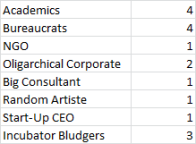I can only write this because this blog is private, of course. Note well please….
A couple of year’s back I was approached to be a chairman at the CEO Institute. This is a nationwide forum for CEO’s to meet on a monthly basis in order to (and this bit has been pinched from their website):
- Connect with like-minded leaders and participate in leadership development in a supportive, confidential environment.
- Learn from others’ experiences. Talk with peers about common challenges and be exposed to alternative perspectives on possible solutions.
- Networking. Build a wider network of business and personal contacts.
Initially reluctant, I was eventually talked into taking a role as a chair of a syndicate (a group of say 12-14 CEOs meeting monthly). In a way, I actually talked myself into it, using the old dictum that one learn’s most from the new (to me).
They actually built a whole new syndicate for me, and for the first period I genuinely enjoyed learning how to chair such a thing. It is quite challenging; more so than, say, chairing a company board.
After a period they asked me to take over a second syndicate (the chair had retired), which I did. That didn’t go so well because the group was composed of CEOs, Managing Partners and Founder/Owners of small companies that were incredibly static and had no real desire to change in any way whatsoever.
Which is to say, I didn’t really know what they wanted. I did figure it out in the end. Some of them (the professional service providers) were there for leads, and the rest were there for a tea party, and in case something ever went wrong in their businesses.
Needless to say, that group and I parted ways by mutual agreement, and I focused entirely on the other, far more dynamic, group.
Then I was cold-approached to join The Boardroom. They were a bunch of ex-Chairs that had split from the CEO Institute to form a more ‘modern’ group with a better financial deal for the Chairs, etc. I said ‘no’ of course, just on the principle of professional integrity.
However, that conversation made me aware that the CEO Institute wasn’t a not-for-profit. It was in fact a privately owned and very profitable company. Not to worry, it’s not all about the money.
However over the last year the CEO Institute has had troubles with its sales and marketing, i.e. finding new CEO members. Also there has been an ever increasing number of people leaving due to time and cost pressures, amongst other reasons.
The problem is the ‘product’ itself. Essentially it is a Lions or Rotary Club on steroids. Developed in the early 1990’s, and the product just hadn’t been adapted to the changing business environment. The owner either doesn’t see the need, or isn’t interested in investing in R&D.
By way of example, all communications to members and chairs are via email. There is not a web-based communications system. Meeting reports and annual reviews are all done by paper and pen – I kid you not. These days, if I have to write anything longer than an departure and customs card by hand, I get cranky. Actually even the departure and customs cards piss me off given all that duplicated info I have to write time after time – why not an app?
The CEO Institute could only be described as one that is resistant to change, from the top down. And that is not a good thing for a CEO mentoring organisation, you would think, especially in these times of IT-led business ‘chaos’ (as they call it, LOL).
In a way, it doesn’t matter because the institute seems to attract CEOs from SMEs and not from the big end of town. And in Australia, SMEs rarely lead any change; generally they just respond to it when they are forced to.
So once again, I didn’t see any cause for concern from my point of view. It is someone else’s problem and this activity only represents a very small fraction of my monthly activities.
I was then confidentially approached by the CEO Institute’s head of Sales and Marketing. She told me that the conversion of new member leads had recently dropped precipitously, and that she couldn’t get the organisation to respond in any way other than to chase more leads.
She asked me what I thought the product would look like in the ideal world. I noted a number of recurring issues that the members of my group continued to complain about, which could be addressed by these changes to the ‘product’:
1. Shorter 2.5 hours long sessions – the current ones are way too long for my time-poor CEOs. I have come around to the early starts (730am for god’s sake!) and I believe if they were just 2.5 hours long we would get higher attendances.
2. Allow for additional and optional paid one-on-one mentoring and company strategic advisory efforts to enhance financial return to Chairs. At the moment the amount of money on the table for Chairs isn’t very high so they are not attracting the best possible Chairs.
3. I would weed out the Chairs that are consultants or professional mentors (an oxymoron if there ever was one). I would look to ensure all the Chairs were active senior executives and not professional advisers.
4. I would add an app-based membership information system complete with subscriptions to key journals like the HBR, calendars, messaging systems etc.
5. I would add business school qualifications to the benefits of time spent in the groups . This would help with attendance and membership.
6. I would only do guest talks from invited current CEOs, Senior Partners and VPs and not from consultants that are really just promoting their services. The inherent conflict of interest is too apparent in all but the rarest cases. Also active senior managers have much more interesting case studies to talk about.
7. This is the tricky one – but I would somehow get top executive head-hunters into the groups on a weekly basis for a quick meet and greet – these relationships would be a clincher for people wanting to join the groups (the hard bit is that their companies are paying but I can see how this could be managed).
Because most of my group are ’employed’ as CEOs, their strategic input into their business is unusually limited. None of them really get to define product initiatives or business strategy. None of them have ever raised equity or sold companies. This means that the group doesn’t really have any meaty strategic discussions that would help individual members. We only get to discuss second order stuff, which can get a little tedious after a while.
Interestingly, only one of member in my group has any interest in starting his own company. The rest of them have the career goal of jumping from one CEO role to the next bigger one, always remaining an employee in an established company. Therefore they are also strangely focused on learning how to get up that greasy pole whilst minimising the risks of slipping down it (namely, completely suppressing any functional individuality or strategic risk-taking).
One feature of the CEO Institute that I continually have to ignore is the CC email trains between the Chairs and the CEO of the CEO Institute. You have never seen so much vacuous dribble in your life (e.g. “Oh no! Susan, how I will miss your amazing kindness, intellect and warmth. You have inspired me as Chairman on so many levels”). Actually this stuff is so entertaining that I sort of see it as an upside in an odd sort of way.
By sheer happenstance, recently a number of my members left the group at the same time; this because they became unemployed or changed jobs and found their new employer less willing to pay for their membership, or less amenable to the time commitment of the CEO away from the business.
At this point (right now) the group becomes non-viable to the CEO Institute because costs are too high for the revenue it generates from membership fees. In the absence of new members (due to the drop in new sales conversions at head office), the only solution is to merge two groups into one larger group. It’s been happening all year to other groups.
Knowing all this, I believe that I have made sure that I won’t be promoted as the Chair of a merged group. Although all of these issues are ‘someone else’s problem’, I am also becoming a little bored of the format of the meetings. After two years, even with new invited speakers each month, it appears to me that we are starting to go around in circles that we have seen many times before.
One thing is for sure, this isn’t my problem. This is a for-profit company and if they can’t sort their own shit out, then that has nothing to do with me. Gone are the days when I feel the need to spuriously help others. The pigs, they never thank you, even if it works.
So how did I make sure that I won’t be the Chair of the upcoming merged group? Well I just filled out the Chair’s (hand-written) annual report with more honesty than would be expected from anyone in the corporate world. Not a lot of honesty, mind. Just a little more than the usual honey-coated bullshit that people say and write.
The clincher would have been this: Q: “The level of assistance provided by the Chairman (sic) in the recruitment of new members”. A: “My business networks are mostly in high-growth and high-tech industries and it would likely be ineffective to promote the CEO Institute’s product within these circles”.
And I think, with some luck, that it has done the trick. It was starting to worry me, how I would get out. I didn’t want to be seen to be abandoning my group. This way, it’s an act of god, or some-such.
And there endeth the lesson, for now. Who knows how I might apply these learnings in the future. But one thing’s for sure, it’s been damn interesting and certainly not time wasted, from any perspective.
But it is very important to recognise when you’ve hit the Pareto limit, where your potential for future benefits start to diminish asymptotically. This is of course a business judgement call; but if you can’t make one of these then why would you be a Chair in the first place!






































